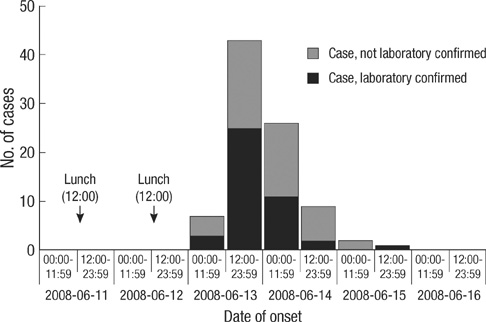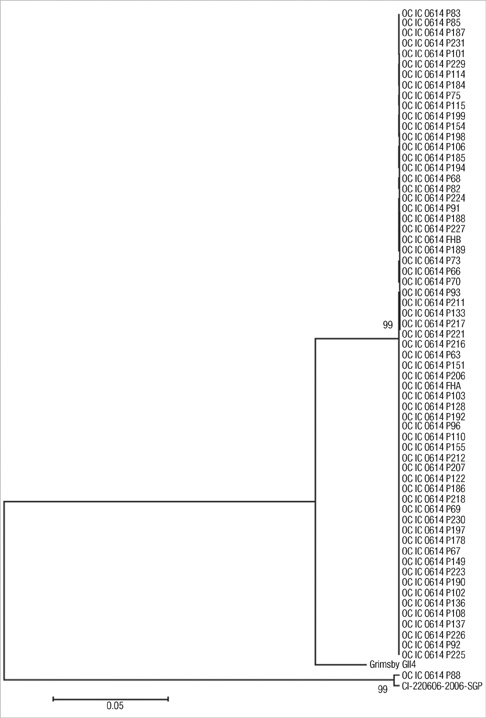J Korean Med Sci.
2010 Aug;25(8):1128-1133. 10.3346/jkms.2010.25.8.1128.
Epidemiology of Foodborne Norovirus Outbreak in Incheon, Korea
- Affiliations
-
- 1Department of Gastroenterology, Ajou University School of Medicine, Suwon, Korea. dubogi@hanmail.net
- 2Department of Pediatrics, Gachon University of Medicine and Science, Incheon, Korea.
- 3Incheon Metropolitan Government Research Institute of Public Health and Environment, Incheon, Korea.
- 4Department of Preventive and Social Medicine, College of Medicine, Inha University, Incheon, Korea.
- KMID: 1714031
- DOI: http://doi.org/10.3346/jkms.2010.25.8.1128
Abstract
- On June 14, 2008, an outbreak of gastroenteritis occurred among elementary school students in Incheon. We conducted an investigation to identify the source and described the extent of the outbreak. We performed a retrospective cohort study among students, teachers and food handlers exposed to canteen food in the elementary school. Using self-administered questionnaires we collected information on symptoms, days of canteen food eaten, food items consumed. Stool samples were collected from 131 symptomatic people and 11 food handlers. The catering kitchen was inspected and food samples were taken. Of the 1,560 people who ate canteen food, 117 were symptomatic cases, and the attack rate was 7.5%. Consumption of cucumber-crown daisy salad (RR=2.71), fresh cabbage mix (RR=2.23), dried radish salad (RR=3.04) and young radish kimchi (RR=2.52) were associated with illness. Sixty-four (45%) of the 142 stool specimens were positive for Norovirus. Norovirus was detected in 2 food handlers. Interviews with kitchen staff indicated the likelihood of contamination from an infected food handler to the dried radish salad during food processing. The excretion of Norovirus from asymptomatic food handlers may be an infection source of Norovirus outbreaks.
Keyword
MeSH Terms
Figure
Cited by 3 articles
-
Noroviruses: Recent Updates
Ju-Young Chung
Pediatr Gastroenterol Hepatol Nutr. 2012;15(1):1-7. doi: 10.5223/pghn.2012.15.1.1.Food poisoning
Chang-Beom Ryu, Moon-Sung Lee
J Korean Med Assoc. 2011;54(6):617-626. doi: 10.5124/jkma.2011.54.6.617.Molecular Characterization of Norovirus and Rotavirus in Outbreak of Acute Gastroenteritis in Seoul
Se-Ah Oh, Sang-Hun Park, Hee-Jin Ham, Hyun-Jung Seung, Jung-Im Jang, Sang-Won Suh, Suk-Ju Jo, Sung-Min Choi, Hae-Sook Jeong
J Bacteriol Virol. 2013;43(4):307-316. doi: 10.4167/jbv.2013.43.4.307.
Reference
-
1. Rockx B, De Wit M, Vennema H, Vinje J, De Bruin E, Van Duynhoven Y, Koopmans M. Natural history of human calicivirus infection: a prospective cohort study. Clin Infect Dis. 2002. 35:246–253.2. Fretz R, Svoboda P, Luthi TM, Tanner M, Baumgartner A. Outbreaks of gastroenteritis due to infections with Norovirus in Switzerland, 2001-2003. Epidemiol Infect. 2005. 133:429–437.
Article3. Kuusi M, Nuorti JP, Maunula L, Minh Tran NN, Ratia M, Karlsson J, von Bonsdorff CH. A prolonged outbreak of Norwalk-like calicivirus (NLV) gastroenteritis in a rehabilitation centre due to environmental contamination. Epidemiol Infect. 2002. 129:133–138.
Article4. Marks PJ, Vipond IB, Regan FM, Wedgwood K, Fey RE, Caul EO. A school outbreak of Norwalk-like virus: evidence for airborne transmission. Epidemiol Infect. 2003. 131:727–736.
Article5. Parashar U, Quiroz ES, Mounts AW, Monroe SS, Fankhauser RL, Ando T, Noel JS, Bulens SN, Beard SR, Li JF, Bresee JS, Glass RI. "Norwalk-like viruses." Public health consequences and outbreak management. MMWR Recomm Rep. 2001. 50:1–17.6. Iversen AM, Gill M, Bartlett CL, Cubitt WD, McSwiggan DA. Two outbreaks of foodborne gastroenteritis caused by a small round structured virus: evidence of prolonged infectivity in a food handler. Lancet. 1987. 2:556–558.
Article7. Kilgore PE, Belay ED, Hamlin DM, Noel JS, Humphrey CD, Gary HE Jr, Ando T, Monroe SS, Kludt PE, Rosenthal DS, Freeman J, Glass RI. A university outbreak of gastroenteritis due to a small round-structured virus. Application of molecular diagnostics to identify the etiologic agent and patterns of transmission. J Infect Dis. 1996. 173:787–793.
Article8. Reid JA, Caul EO, White DG, Palmer SR. Role of infected food handler in hotel outbreak of Norwalk-like viral gastroenteritis: implications for control. Lancet. 1988. 2:321–323.
Article9. Parashar UD, Dow L, Fankhauser RL, Humphrey CD, Miller J, Ando T, Williams KS, Eddy CR, Noel JS, Ingram T, Bresee JS, Monroe SS, Glass RI. An outbreak of viral gastroenteritis associated with consumption of sandwiches: implications for the control of transmission by food handlers. Epidemiol Infect. 1998. 121:615–621.
Article10. KCDC. Service DoEI. Epidemiological investigation report of mass food poisoning in the Metropolitan area, Korea, 2006. 2006-2007. Seoul: Korea Centers for Disease Control and Prevention;169–181.11. Kim SH, Cheon DS, Kim JH, Lee DH, Jheong WH, Heo YJ, Chung HM, Jee Y, Lee JS. Outbreaks of gastroenteritis that occurred during school excursions in Korea were associated with several waterborne strains of norovirus. J Clin Microbiol. 2005. 43:4836–4839.
Article12. Lee HJ, Lee SW, Bang JH, Lim DJ, En SH, Park MS, Sin HJ. Service Do EI. Norwalk-virus food poisoning epidemiological investigation, Seoul, Korea, 2003. 2003-2004. Seoul: Korea Centers for Disease Control and Prevention;103–113.13. Widdowson MA, Sulka A, Bulens SN, Beard RS, Chaves SS, Hammond R, Salehi ED, Swanson E, Totaro J, Woron R, Mead PS, Bresee JS, Monroe SS, Glass RI. Norovirus and foodborne disease, United States, 1991-2000. Emerg Infect Dis. 2005. 11:95–102.
Article14. Ozawa K, Oka T, Takeda N, Hansman GS. Norovirus infections in symptomatic and asymptomatic food handlers in Japan. J Clin Microbiol. 2007. 45:3996–4005.
Article15. Tu ET, Bull RA, Kim MJ, McIver CJ, Heron L, Rawlinson WD, White PA. Norovirus excretion in an aged-care setting. J Clin Microbiol. 2008. 46:2119–2121.
Article16. Atmar RL, Opekun AR, Gilger MA, Estes MK, Crawford SE, Neill FH, Graham DY. Norwalk virus shedding after experimental human infection. Emerg Infect Dis. 2008. 14:1553–1557.
Article17. Keswick BH, Satterwhite TK, Johnson PC, DuPont HL, Secor SL, Bitsura JA, Gary GW, Hoff JC. Inactivation of Norwalk virus in drinking water by chlorine. Appl Environ Microbiol. 1985. 50:261–264.
Article
- Full Text Links
- Actions
-
Cited
- CITED
-
- Close
- Share
- Similar articles
-
- Epidemiological investigation on the outbreak of foodborne and waterborne disease due to Norovirus with delayed notification
- Norovirus Outbreak in a Kindergarten: Human to Human Transmission among Children
- Effectiveness of Norovirus Outbreak Management Protocol for Controlling Outbreak of Norovirus in Pediatric Wards
- Trends in Water- and Foodborne Disease Outbreaks in Korea, 2007–2009
- Molecular Characteristics of Noroviruses Genogroup I and Genogroup II Detected in Patients With Acute Gastroenteritis



